Life Sciences
In fluorescence spectroscopy, light from a broadband light source or a laser is incident upon a sample which may then emit a weak fluorescence signal. A Fluorescence filter set usually consists of an excitation filter, dichroic filter and emission filter combined in a filter cube. Excitation filters are used to ensure that only the desired wavelength is incident upon the sample while an emission filter is used to pass the fluorescence signal and reject the excitation light and any undesirable light. A dichroic filter is typically used at an angle of incidence of 45° to reflect excitation light to the sample and transmit the emitted signal to the detector. The excitation, emission and dichroic filter are commonly used in a set to maximize the desired signal and minimize any undesired signal.

Fluorescence spectroscopy is widely used in many biomedical applications including Confocal Microscopy and Flow Cytometry.
Main Production for Life Sciences
Bandpass Filters
Raman Filters
Dichroic mirrors
Optical Lens
Cylindrical Lens
Metal mirrors
Optical Windows
Optical Prisms


